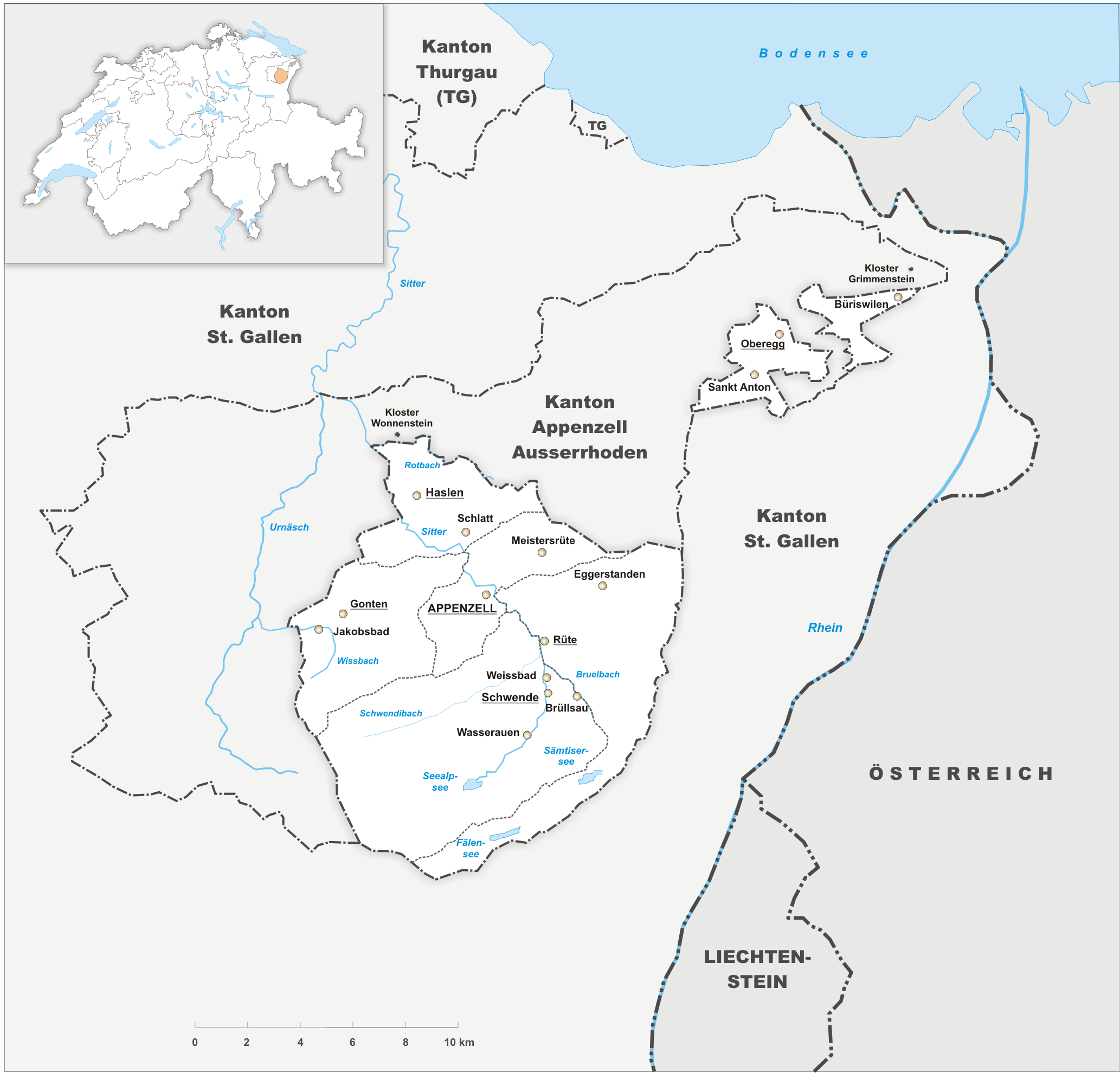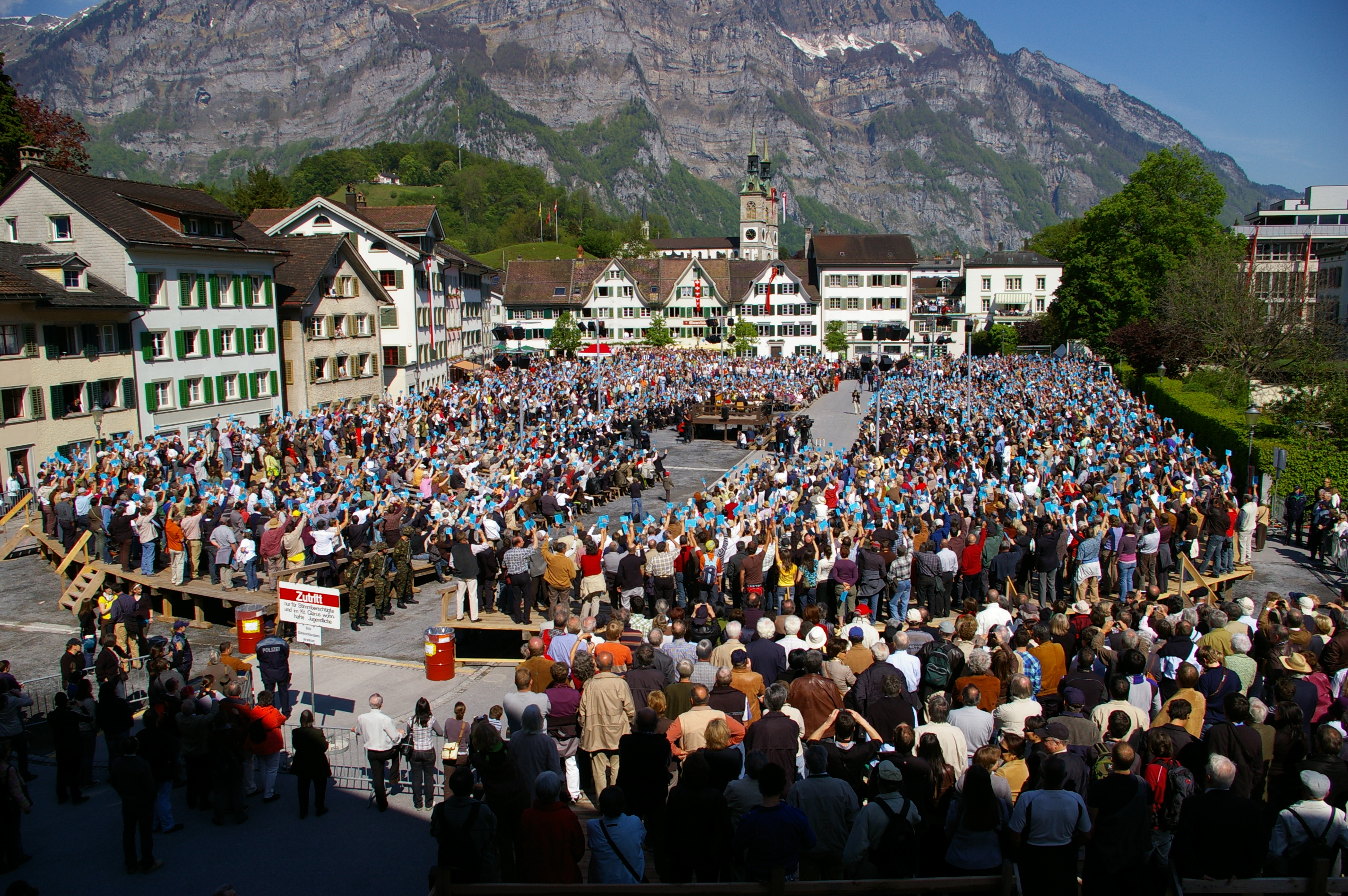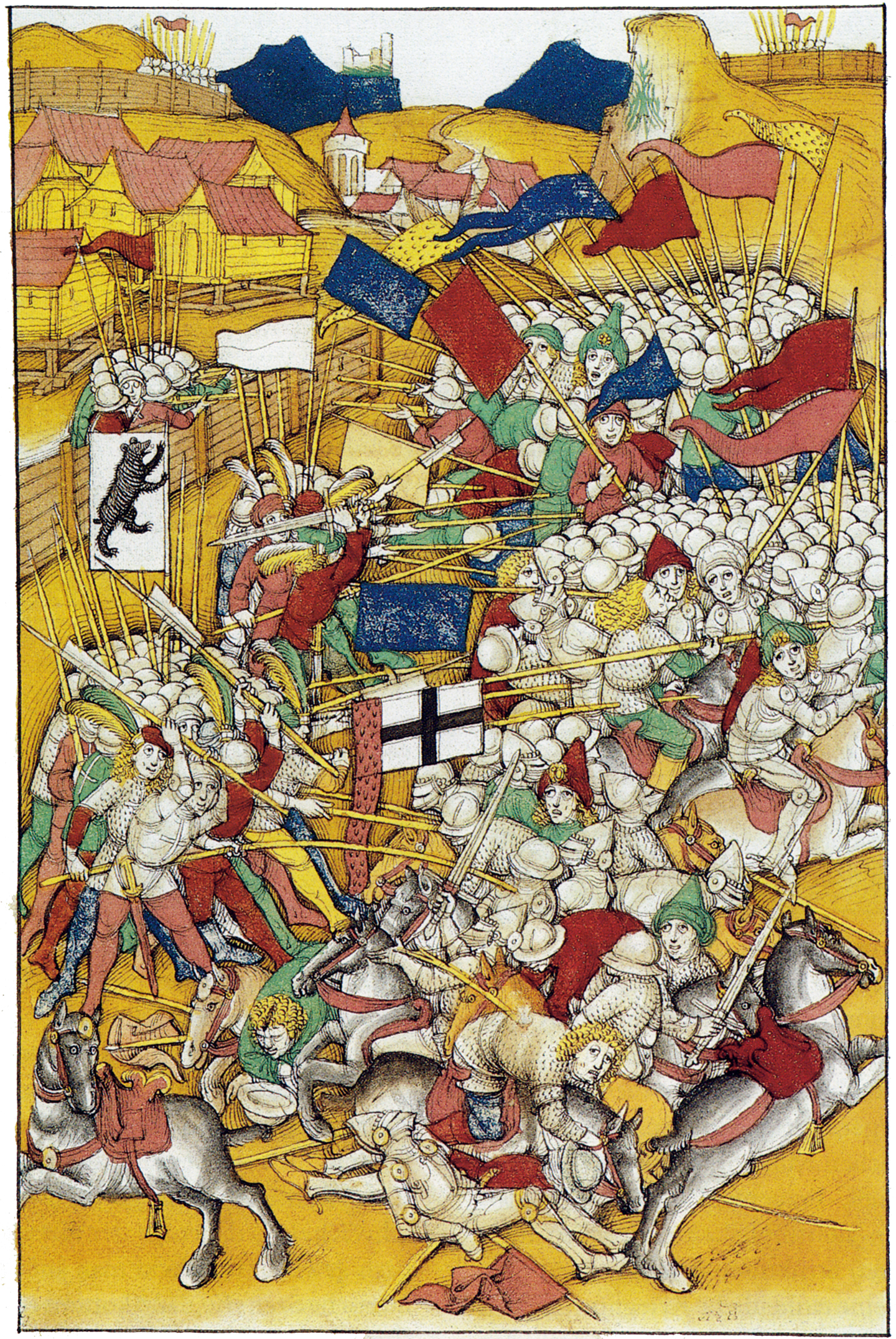|
Innerrhoden
Appenzell Innerrhoden (; in English sometimes Appenzell Inner-Rhodes) (german: Kanton Appenzell Innerrhoden rm, Chantun Appenzell Dadens; french: Canton d'Appenzell Rhodes-Intérieures; it, Canton Appenzello Interno) is one of the 26 cantons forming the Swiss Confederation. It is composed of six districts. The seat of the government and parliament is Appenzell. It is traditionally considered a "half-canton", the other half being Appenzell Ausserrhoden. Appenzell Innerrhoden is the smallest canton of Switzerland by population and the second smallest by area. It is located in the north east of the country. Together with the canton of Appenzell Ausserrhoden, it forms an enclave within the canton of St. Gallen. The canton is essentially located in the Alpine foothills of the Alpstein massif, culminating at the Säntis. Appenzell Innerrhoden was part of the historical canton of Appenzell, which was divided into Appenzell Ausserrhoden (Protestant) and Appenzell Innerrhoden (Cat ... [...More Info...] [...Related Items...] OR: [Wikipedia] [Google] [Baidu] |
Landsgemeinde
The ''Landsgemeinde'' ("cantonal assembly"; , plural ''Landsgemeinden'') is a public, non-secret ballot voting system operating by majority rule, which constitutes one of the oldest forms of direct democracy. Still at use – in a few places – at the subnational political level in Switzerland, it was formerly practiced in eight cantons. For practical reasons, the ''Landsgemeinde'' has been abolished at the cantonal level in all but two cantons where it still holds the highest political authority: Appenzell Innerrhoden and Glarus. The ''Landsgemeinde'' is also convened in some districts of Appenzell Innerrhoden, Grisons and Schwyz to vote on local questions. The German term ''Landsgemeinde'' itself is attested from at least the 16th century, in the 1561 dictionary of Pictorius. It is a compound from ''Land'' "land, canton; rural canton" and ''Gemeinde'' "community, commune". Eligible citizens of the canton or district meet on a certain day in the open air to decide on specif ... [...More Info...] [...Related Items...] OR: [Wikipedia] [Google] [Baidu] |
Cantons Of Switzerland
The 26 cantons of Switzerland (german: Kanton; french: canton ; it, cantone; Sursilvan and Surmiran: ; Vallader and Puter: ; Sutsilvan: ; Rumantsch Grischun: ) are the member states of the Swiss Confederation. The nucleus of the Swiss Confederacy in the form of the first three confederate allies used to be referred to as the . Two important periods in the development of the Old Swiss Confederacy are summarized by the terms ('Eight Cantons'; from 1353–1481) and ('Thirteen Cantons', from 1513–1798).rendered "the 'confederacy of eight'" and "the 'Thirteen-Canton Confederation'", respectively, in: Each canton of the Old Swiss Confederacy, formerly also ('lieu/locality', from before 1450), or ('estate', from ), was a fully sovereign state with its own border controls, army, and currency from at least the Treaty of Westphalia (1648) until the establishment of the Swiss federal state in 1848, with a brief period of centralised government during the Helvetic Republic ( ... [...More Info...] [...Related Items...] OR: [Wikipedia] [Google] [Baidu] |
Canton Of Switzerland
The 26 cantons of Switzerland (german: Kanton; french: canton ; it, cantone; Sursilvan and Surmiran: ; Vallader and Puter: ; Sutsilvan: ; Rumantsch Grischun: ) are the member states of the Swiss Confederation. The nucleus of the Swiss Confederacy in the form of the first three confederate allies used to be referred to as the . Two important periods in the development of the Old Swiss Confederacy are summarized by the terms ('Eight Cantons'; from 1353–1481) and ('Thirteen Cantons', from 1513–1798).rendered "the 'confederacy of eight'" and "the 'Thirteen-Canton Confederation'", respectively, in: Each canton of the Old Swiss Confederacy, formerly also ('lieu/locality', from before 1450), or ('estate', from ), was a fully sovereign state with its own border controls, army, and currency from at least the Treaty of Westphalia (1648) until the establishment of the Swiss federal state in 1848, with a brief period of centralised government during the Helvetic Republic (179 ... [...More Info...] [...Related Items...] OR: [Wikipedia] [Google] [Baidu] |
Half-canton
The 26 cantons of Switzerland (german: Kanton; french: canton ; it, cantone; Sursilvan and Surmiran: ; Vallader and Puter: ; Sutsilvan: ; Rumantsch Grischun: ) are the member states of the Swiss Confederation. The nucleus of the Swiss Confederacy in the form of the first three confederate allies used to be referred to as the . Two important periods in the development of the Old Swiss Confederacy are summarized by the terms ('Eight Cantons'; from 1353–1481) and ('Thirteen Cantons', from 1513–1798).rendered "the 'confederacy of eight'" and "the 'Thirteen-Canton Confederation'", respectively, in: Each canton of the Old Swiss Confederacy, formerly also ('lieu/locality', from before 1450), or ('estate', from ), was a fully sovereign state with its own border controls, army, and currency from at least the Treaty of Westphalia (1648) until the establishment of the Swiss federal state in 1848, with a brief period of centralised government during the Helvetic Republic (1798� ... [...More Info...] [...Related Items...] OR: [Wikipedia] [Google] [Baidu] |
List Of Cantonal Legislatures Of Switzerland
This is a list of cantonal legislatures of Switzerland. Each canton has a democratically elected cantonal legislature, as well as elected members to the Federal Assembly. The cantonal legislatures are elected for four years, except in Fribourg, Vaud, Geneva and Jura, which elect their legislatures for five years. The largest legislature, in Zürich, has 180 members, whilst the smallest, in less-populous Appenzell Innerrhoden, has onlyGR 49 members. Appenzell Innerrhoden is also the only legislature that is non-partisan. All other legislatures operate party political systems. The Swiss People's Party (SVP/UDC) and FDP.The Liberals are the largest party in eight legislatures each, whilst the Christian Democratic People's Party (CVP/PDC) is the largest in six and the Social Democratic Party (SP/PS) is the largest in three. Two cantons, Appenzell Innerrhoden and Glarus, hold ' as their highest legislative body. Under this system, a form of direct democracy, all adult citizen ... [...More Info...] [...Related Items...] OR: [Wikipedia] [Google] [Baidu] |
Grosser Rat
This is a list of cantonal legislatures of Switzerland. Each canton has a democratically elected cantonal legislature, as well as elected members to the Federal Assembly. The cantonal legislatures are elected for four years, except in Fribourg, Vaud, Geneva and Jura, which elect their legislatures for five years. The largest legislature, in Zürich, has 180 members, whilst the smallest, in less-populous Appenzell Innerrhoden, has onlyGR 49 members. Appenzell Innerrhoden is also the only legislature that is non-partisan. All other legislatures operate party political systems. The Swiss People's Party (SVP/UDC) and FDP.The Liberals are the largest party in eight legislatures each, whilst the Christian Democratic People's Party (CVP/PDC) is the largest in six and the Social Democratic Party (SP/PS) is the largest in three. Two cantons, Appenzell Innerrhoden and Glarus, hold ' as their highest legislative body. Under this system, a form of direct democracy, all adult citizens ... [...More Info...] [...Related Items...] OR: [Wikipedia] [Google] [Baidu] |
Appenzell
Appenzell is a historic canton in the northeast of Switzerland, and entirely surrounded by the canton of St. Gallen. Appenzell became independent of the Abbey of Saint Gall in 1403 and entered a league with the Old Swiss Confederacy in 1411, becoming a full member in 1513. It has been divided since into Appenzell Innerrhoden and Appenzell Ausserrhoden since 1597 as a result of the Swiss Reformation. The territory of Appenzell as a geographical entity is known as ''Appenzellerland'' while in political contexts, the two cantons (until 1999 half-cantons) are referred to as ''beide Appenzell'' ("both Appenzells"). History Foundation The name ''Appenzell'' derives from la, abbatis cella 'cell (i.e., estate) of the abbot'. This refers to the Abbey of St. Gall, which exerted a great influence on the area. By the middle of the 11th century the abbots of St Gall had established their power in the land later called Appenzell, which by that time was thoroughly Alemannic. By ab ... [...More Info...] [...Related Items...] OR: [Wikipedia] [Google] [Baidu] |
Säntis
At above sea level, Säntis is the highest mountain in the Alpstein massif of northeastern Switzerland. It is also the culminating point of the whole Appenzell Alps, between Lake Walen and Lake Constance. Shared by three cantons, the mountain is a highly visible landmark thanks to its exposed northerly position within the Alpstein massif. As a consequence, houses called ''Säntisblick'' (English: ''Säntis view'') can be found in regions as far away as the Black Forest in Germany. Säntis is among the most prominent summits in the Alps and the most prominent summit in Europe with an observation deck on the top. The panorama from the summit is spectacular. Six countries can be seen if the weather allows: Switzerland, Germany, Austria, Liechtenstein, France, and Italy. Geography Säntis is located in the Alpstein region, nearly (as the crow flies) southwest of the town of Appenzell. Three cantons meet on Säntis: Appenzell Ausserrhoden, Appenzell Innerrhoden, and St. Galle ... [...More Info...] [...Related Items...] OR: [Wikipedia] [Google] [Baidu] |
Appenzell Ausserrhoden
Appenzell Ausserrhoden (; in English sometimes Appenzell Outer Rhodes) (german: Kanton Appenzell Ausserrhoden; rm, Chantun Appenzell Dadora; french: Canton d'Appenzell Rhodes-Extérieures; it, Canton Appenzello Esterno) is one of the 26 cantons forming the Swiss Confederation. It is composed of twenty municipalities. The seat of the government and parliament is Herisau, and the seat of judicial authorities are in Trogen. It is traditionally considered a " half-canton", the other half being Appenzell Innerrhoden. Appenzell Ausserrhoden is located in the north east of Switzerland. Together with the canton of Appenzell Innerrhoden, it forms an enclave within the canton of St. Gallen. The canton is essentially located in the Alpine foothills of the Alpstein massif, culminating at the Säntis. Appenzell Ausserrhoden was part of the historical canton of Appenzell, which was divided into Appenzell Innerrhoden (Catholic) and Appenzell Ausserrhoden (Protestant) in 1597 as a result of ... [...More Info...] [...Related Items...] OR: [Wikipedia] [Google] [Baidu] |
Districts Of Switzerland
Districts of Switzerland are a political subdivision for cantons. In the federally constituted Switzerland, each canton is completely free to decide its own internal organisation. Therefore, there exists a variety of structures and terminology for the subnational entities between canton and municipality, loosely termed districts. Most cantons are divided into ''Bezirke'' (German for districts, singular ''Bezirk''). They are also termed ''Ämter'' ( Lucerne, singular ''Amt''), ''Amtsbezirke'' ( Bern, ''Amtsbezirk''), ''district'' (in French) or ''distretto'' (Ticino and part of Graubünden). The ''Bezirke'' generally provide only administration and court organization. However, for historical reasons districts in cantons Graubünden and Schwyz are their own legal entities with jurisdiction over tax and often have their own Landsgemeinde. Seven of the 26 cantons – Uri, Obwalden, Nidwalden, Glarus, Zug, Basel-City and Geneva – have always existed without the district lev ... [...More Info...] [...Related Items...] OR: [Wikipedia] [Google] [Baidu] |
List Of Cantonal Executives Of Switzerland
This article lists the cantonal executives of Switzerland. Each canton of Switzerland has its own executive body, as well as legislative body. The Federal Council is the executive of the Swiss federal government, and is included for purposes of comparison. The cantonal executives are collegial bodies, each with 5 or 7 members. They are generally called ' (Executive Council) in German-speaking cantons and ' (State Council) in French-speaking cantons. General structure Presidents of the executives The above mentioned collegial bodies are formally chaired by a president. However those presidents are primus inter pares, that is a ''first among equals'' in the council. Other than presiding over meetings and the ability to cast tie-breaking votes the president only holds ceremonious powers. In the list below, if nothing else is noted, the official name of the office of president of the respective cantonal executive is ''Regierungsratspräsident'' (Government council pre ... [...More Info...] [...Related Items...] OR: [Wikipedia] [Google] [Baidu] |
Switzerland
). Swiss law does not designate a ''capital'' as such, but the federal parliament and government are installed in Bern, while other federal institutions, such as the federal courts, are in other cities (Bellinzona, Lausanne, Luzern, Neuchâtel, St. Gallen a.o.). , coordinates = , largest_city = Zürich , official_languages = , englishmotto = "One for all, all for one" , religion_year = 2020 , religion_ref = , religion = , demonym = , german: Schweizer/Schweizerin, french: Suisse/Suissesse, it, svizzero/svizzera or , rm, Svizzer/Svizra , government_type = Federalism, Federal assembly-independent Directorial system, directorial republic with elements of a direct democracy , leader_title1 = Federal Council (Switzerland), Federal Council , leader_name1 = , leader_title2 = , leader_name2 = Walter Thurnherr , legislature = Fe ... [...More Info...] [...Related Items...] OR: [Wikipedia] [Google] [Baidu] |






